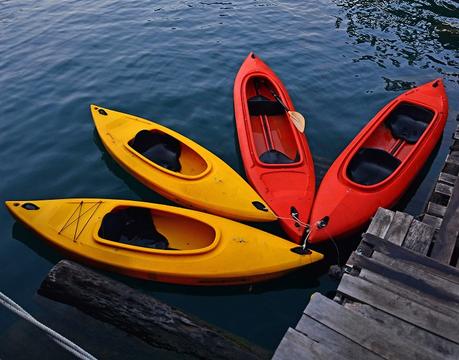
One of the never-ending debates has to be the canoes vs kayaks debate and which one is the best, especially for beginners. This can be solved by knowing what you will be using the canoe or kayak for.
Canoeing is usually a recreational activity in which you either kneel or face forward in a closed or open canon. You then propel yourself forward using your power and a single-bladed paddle.
On the other hand, kayaking involves moving across the water and the difference between it and canoeing is in the number of blades as well as the paddler’s sitting position.
In a kayak, the paddler sits facing forward and then propels themselves forward using a double-bladed paddle or a kayak paddle with rubber grip. A majority of kayaks have closed decks.
Additionally, kayaks are slimmer and have an enclosed cockpit that provides room to store your belongings as well as gear while canoes resemble boats in that they have open decks that can fit luggage, people and small animals.
If you are a beginner, you might want to find out more about canoes and kayaks before you make a decision. In this guide, we are going to look at the differences between the two, including their pros and cons.
What Are Kayaks
A kayak is a slim boat that has pointy ends both at the rear and the front. One paddler will usually sit in the middle of the boat, inside a cockpit that has a low seat and propel the boat by paddling at each side of the kayak.
The paddler alternates on each of the sides using circular motions of the paddle, ensuring that each blade enters the water in turn. As you will find out later on, some kayaks are open in that the paddler doesn’t sit low inside a cockpit but on the kayak’s hull.
At the end of the day, however, regardless of the type of kayak, the paddler will be sitting facing forward with their legs positioned in front.
Short History of Kayaks
Kayaks can be traced back thousands of years ago since they were used by Eskimo and Inuit people, who were natives of Northern parts of America as well as the Arctic regions.
The word kayak in Eskimo simply means ‘man-boat’. Originally, kayaks were crafted out of driftwood using whale bones and animal skin to seal the boat to ensure that it is waterproof.
Sealed with animal fat, mainly whale or caribou fat, kayaks were used primarily for hunting. They were also used for transportation, where the natives would use them to transport belongings in a dry and enclosed environment.
The design of the kayaks made it possible to maneuver across icy waters while being as stealthy as possible when hunting. Later on in the 1800s, the kayak was introduced in Europe and would slowly gain popularity among explorers and sportsmen.
It was, however, not until 1936 that kayaking was introduced as an Olympic Sport in the Berlin Olympic Games that year.
Benefits of Using Kayaks
Whether you are looking to engage in kayaking as a recreational activity, for sport or fishing, there are a few benefits of owning a kayak that you need to be aware of.
Comfort
Kayaking is a comfortable activity, especially for big guys. While a kayak for big guys should be comfortable and spacious, it’s not always easy finding one that fits you.
Most big guys especially put off kayaking for the mere reason that they aren’t sure of finding a kayak that can fit their size.
Thanks to the many advancements that continue to be made today, it is very easy to find a kayak that can work for you even as a beginner and the good news is that, regardless of the kayak you settle for, it will be just as comfortable as any other boat.
Supported Weight
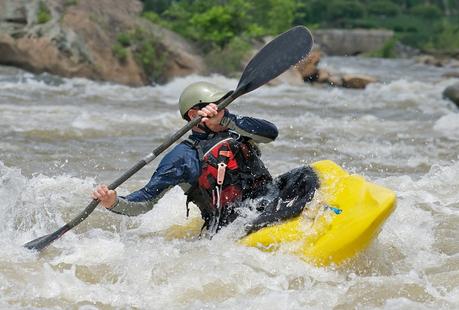
Every kayak is usually designed with specific weight capacity; hence it’s up to you to ensure that you get one that fits your weight.
The main reason why you need to pay attention to the weight is to ensure that the kayak is stable enough such that you don’t tip over when you are on the water, especially if you will be paddling alone.
Right Capacity
Whether it’s the storage capacity or the weight, all these features are catered for in any kayak that you get. That said, a majority of kayaks have enough capacity such that you can load up all your gear and not to mention enough room to fit you as well.
Stability
A majority of kayaks on the market tend to be stable and are designed with every type of paddler in mind, including big guys. This stability is important in ensuring that you don’t tip over when you are on the water, which can lead to all manner of serious accidents.
Pros and Cons of Kayaking
Just like when you want to catch a trout with a spinning rod, there are pros and cons of owning a kayak that you need to be aware of before you make any purchasing decisions.
Pros
- It is very easy to pick up kayaking basics, although while learning how to kayak, use a beginners’ kayak to be on the safe side.
- Kayaks move faster with little effort exerted by the paddler compared to canoes.
- There are a lot more varieties in kayaking disciplines than canoeing.
- Your gear will always be dry in a kayak than a canoe as long as you don’t end up capsizing.
- Compared to canoes, kayaks are easier and lighter in weight, making transportation easy and stress-free.
- Kayaks are much more maneuverable than canoes.
- Kayaks tend to handle whitewater way better than canoes.
- In a kayak, you are close to the water, which makes you feel much more connected with the water, something that passionate anglers find thrilling.
- The double paddles of kayaks tend to be way more efficient than the single ones found in canoes.
Cons
- With a kayak, it’s unlikely that at the end of it all, you will be completely dry.
- It takes a long time to master the more advanced kayaking skills.
- It can be scary transitioning from flatwater kayaking to fast-moving water, especially if you are a beginner.
- Using spray kits that are common in kayaks can be a little scary for beginners and improvers.
- Double paddles tend to be heavier than the single paddles used in canoes.
Types of Kayaks
When it comes to kayaking, there are so many different types of kayaks, even more than canoes on the market, each with its specific use.
Sit Inside Kayak
Sit inside kayaks get their name from how your body stays in relation to the kayak, whereby the body is protected when you are inside the kayak.
A sit-inside kayak is usually recommended for those who are looking to kayak all year long and are looking for ways to stay dry and warm when on the water.
At the end of the day, however, the small cockpit and the narrow body of a sit-inside kayak makes it hard for bigger people to get in and out of the kayak.
Sit-On-Top Kayak
Sit inside kayaks are ideal for cold weather kayaking, but for warmer climates, you are better off with a sit on top kayak.
Usually, sit on top kayaks are much slower; hence you can’t cover a lot of distance in them as you would in a sleek hulled kayak. That’s why they are much more suited for kayak camping trips.
Such kayaks, as mentioned, are usually used in warmer regions since your entire body is exposed due to the lack of a cockpit in the kayak.
Typically, these kayaks are also wider than the standard kayaks and, as such, tend to be much more stable to stand upon even when you are cruising on open water.
Recreational Kayak
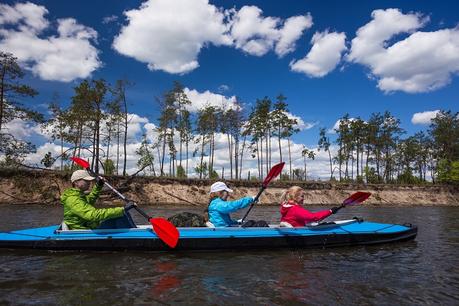
Recreational kayaks are typically the workhorse of the kayak family. Just as the name suggests, they are mainly for recreational kayaking.
They tend to have an enclosed cockpit and are shorter, measuring around 10 feet in length. What this means is that they don’t track well like longer kayaks.
However, since they are made for open water, tracking and quick turning are usually a secondary consideration in such kayaks.
Whitewater Kayak
Whitewater kayaks are wider and shorter than their recreational counterparts, which means that they are highly buoyant and responsive when they are tossed around in whitewater.
The length usually varies depending on the function of the kayak, with playboats measuring around 5.5 feet and river runners measuring 8 to 9 feet in length.
Touring and Sea Kayak
Touring and sea kayaks tend to have a narrower beam than sit on top kayaks and are also longer than standard kayaks, which makes them very fast when you are on the water.
As the name suggests, such kayaks are designed for use by experienced kayakers and sportsmen or anyone else who is planning a long-distance expedition.
Inflatable Kayak
While inflatable kayaks are usually very affordable but less durable than other kayaks, they are still as fun to paddle.
They are used similarly as sit on top kayaks but are easier to transport and additionally, they can easily accommodate two people.
They look like canoes in their open form but are paddled with double paddles and offer not only comfort but playfulness to families and children alike.
Racing Kayak
Racing kayaks are usually light in weight, slender and long and can be paddled by two to four people just as couples can kayak in a tandem kayak easily.
Their size ranges from 17 to 36 feet depending on the number of paddlers that the kayak can accommodate. They also sit very low in the water and have a rudder to help with direction. They are also used mostly on flat water for marathons and sprints.
What Are Canoes
A canoe is a small point ended boat on the two extremes. It is usually propelled by a paddler who kneels or sits on a seat that is raised and uses single-bladed paddles.
While it is not impossible to paddle a canoe with double-bladed paddles, it is rare and uncomfortable. This is because a canoe is usually wider than a regular kayak, hence the reason why double-bladed paddles are not effective.
Canoes are usually open at the top, although some are covered like kayaks. Usually, the canoe can be powered by one or two people.
However, you might also come across those that are powered by a small gas or electric motor, just like with a premium kayak trolling motor or sails as with some designs.
Short History of Canoes
Canoeing is a very old mode of transportation that has been used all around the world in the past years. While kayaks were mainly used by the North American and Arctic dwellers, the canoe was used on a much wider scale.
From Polynesian tribes to American natives, the canoe was a primary mode of transportation that was used for trade as well as during wars.
Where there was water, a canoe was always close at hand. Primitive yet well-constructed, the ancient canoes were made from logs, tree barks, and animal skin.
There are even records of canoes that were as long as 130 feet that were used to transport soldiers and to wage war on neighbors. What is currently the modern recreational canoe originated around the last part of the 19th century.
In 1924, several countries that included Denmark, Germany, Sweden, and Austria founded The International Representation for Canoe Sport that would soon be changed to the International Canoe Federation and it was not until 1936 that canoeing became part of the Olympic games.
Today canoeing is a widespread sport that consists of several disciplines like canoe marathons, canoe sprints, whitewater canoeing, canoe polo, among others.
Additionally, there are associations in several parts of the world, including Canada, the USA, Scotland, and England, that deal with canoeing as a sport.
Benefits of Using Canoes
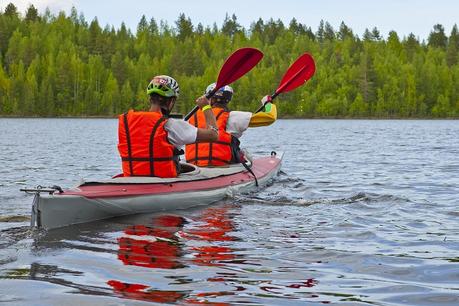
Just like with a kayak, before you go buying a canoe, here are a few benefits that you need to be aware of.
Design
What sets canoes apart from kayaks is in the design. Canoes are designed to be open at the top from stem to stern and tend to have three seats in them.
This means that you have more room for your gear as well as supplies and allows passengers and paddlers to either sit or kneel when you are on the water.
Kayaks, on the other hand, are enclosed and have a small opening where the ride slides in. They are paddled from a seated position with the feet facing forward as you paddle.
Paddles
When it comes to paddles, the ones used in kayaks are slightly different from those used in canoes. Seeing that a kayak can only hold on the rider, the paddles are usually double-bladed.
This design allows you to paddle with the alternating port as well as starboard strokes to stay on course and maintain full control of the kayak.
With canoes, the paddles are usually singularly bladed. However, multiple paddles can be used – one by the person at the bow and the other way one by the one at the stern.
As such, where a kayak relies on one person to steer, in a canoe, it is more of a team effort. You can, therefore, go for that fishing trip that you have meant to with your friends if you have a canoe.
Capacity
One of the good things about a canoe is that unlike a kayak, canoes have enough capacity to fit anything extra you might want to bring with you.
Whether that will be an extra fishing rod, a camp chair or an extra paddle, there is enough room in a canoe to accommodate all that.
Company
Like mentioned earlier, a canoe is dependent on team effort rather than solo steering. As such, there is always room to accommodate a friend and that way; your experience becomes more fun.
They are especially ideal for beginners seeing that you will have someone else with you on the canoe in case you capsize or venture into unknown waters.
Tracking
While kayaks can track just as well, with a canoe, once a rhythm has been established, they can stay on course with very minimal effort.
Visibility
Unlike kayaks that have to be operated in a seating position, if you are careful, one of you can stand up in a canoe and scout for rapids from the boat.
Drier
Since canoes used double-bladed paddles, your hands are much drier at the end and not to mention with fewer blisters. Additionally, the sides of your canoe keep the small waves from swamping you when you are on the water.
Pros and Cons of Canoeing
Just like you would need a dry bag to keep your kayak gear from getting wet, there are a few pros and cons of canoes that you need to be aware of if you are torn between a canoe and a kayak.
Pros
- It is possible to carry a lot of gear in a canoe than a kayak.
- Canoes are ideal for longer expeditions due to their carrying capacity and the fact that they are more comfortable than kayaks.
- Canoes are way more stable than kayaks and don’t capsize easily.
- In a canoe, you can vary your sitting position, which makes it more comfortable than a kayak, especially when you need to cover long distances.
- Unlike in a kayak, you can paddle when standing up in a canoe.
- Once you have learned the basics of canoeing, mastering other canoeing skills is quicker and easier compared to a kayak.
- You don’t get wet in a canoe unless you are paddling in whitewater.
- When in a canoe, you have a better view of the surroundings and can see rapids before you even hit them.
- You can bring your kids and dogs with you in a canoe because there is enough room.
- Canoes are easier to get in and out of even for bigger guys.
Cons
- Canoes are much heavier and transportation is usually a problem.
- It is usually difficult to master basic paddling skills, especially if you are a solo paddler.
- Canoes tend to take on more water than kayaks when you are paddling in whitewater.
- At the end of the day, single-bladed paddles are less efficient than the double-sided ones used in kayaks.
- It takes way more effort to paddle a canoe at top speed than a kayak at the same speed.
Types of Canoes
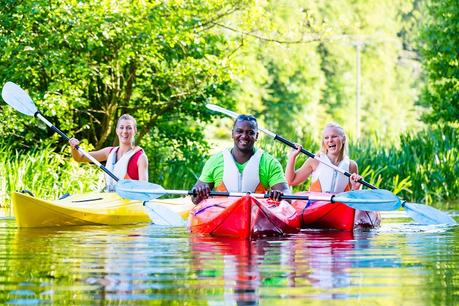
At first glance, a majority of canoes look alike, but if you are an experienced canoeist, you can easily point out the different types of canoes.
Recreational Canoe
They are fun and easy to paddle and are the most common types of canoes. They can be found in the big-box sporting goods stores as rentals and in fleets at summer camps.
If you are looking for a canoe that you can easily paddle around in your local lake, then you are better off with a recreational canoe.
Such canoes are about 17 feet in length and provide a stable as well as an easy to control platform for several people for either birding, fishing, photography or simply taking in sights with friends as well as family.
Recreational canoes are usually made of aluminum or plastic and contain no frills. However, since they are stable, they are not as agile as other types of canoes.
Expedition Canoe
At first glance, they look like recreational canoes, but there are some important distinctions between the two. In general, expedition canoes are meant to offer great maneuverability and have more capacity than the recreational ones.
Measuring about 18 to 20 feet in length, expedition canoes are powered by more than two people and are designed with longer expeditions in mind. Due to their advanced design, such canoes are designed to handle anything from calm lakes to whitewater rivers.
Compared to smaller canoes, expedition canoes are paddled faster when they are full of gear since it compensates for the high amount of displacement and depth.
Whitewater Canoe
While whitewater sports are reserved for kayaks, some canoes are designed to handle that environment as well. Whitewater canoes have higher sides, floatation bags and have a more curved profile referred to as rocker. This means that such canoes are easier to maneuver within difficult waters.
Racing Canoe
Racing canoes are normally narrower than recreational ones and also sit lower in the water. They are designed for both solo and duo racing. The paddler in racing canoes often assumes a half-kneeling half-sitting position for optimal speed and power.
Canoe vs Kayak Differences
Now that you know the history of canoes and kayaks as well as the pros and cons of each and the different types on the market, it’s time to solve the never-ending debate of which is much better.
Here are the few notable differences between canoes and kayak that you need to be aware of before you make a purchase.
Cockpit
Canoes are often open with the sides coming high out of the water, which indicates a lack of a cockpit.
Kayaks, on the other hand, are enclosed and have a cockpit where the paddler sits in. They also sit much lower in the water than canoes, such that water doesn’t come into the kayak through the cockpit.
Seat
The sitting position or lack of one is one of the differences between a canoe and a kayak. Typically, canoes have a raised bench at the center.
This means that your rear end does not get wet when you are paddling and that you can easily access any items you have on board.
With a kayak, you have to either sit or kneel on the floor when you are paddling. A water skirt is meant to keep water out in a kayak, but if any water happens to get in, which will happen eventually, you are looking at several hours of sitting in a puddle of water.
Paddles
When it comes to paddles, the ones in canoes are usually single-bladed and the person paddling the canoe can alternate their strokes on one side of using a specific type of stroke on one side.
The paddles usually measure from anywhere between 40 inches to 54 inches in length, depending on your physical size. Kayak paddles, on the other hand, have two-blades on either side of the paddle shift. This design allows you to maintain a straight course with alternate strokes in the water.
The length of the paddles usually depends on your height and they can be up to 7.5 feet in length.
Design
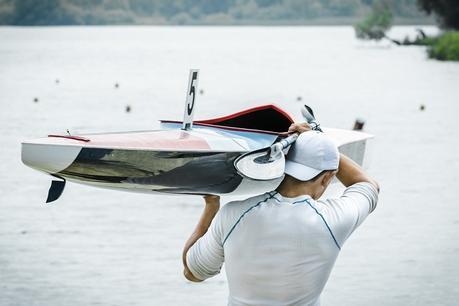
When it comes to design, canoes are open on top. They usually have a sitting bench at either end, close to the stern and another one close to the bow.
If two people are paddling the canoe, they will usually be positioned in front of each other with both facing the same side.
Due to the wide design of the hull, canoes are propelled using single-bladed paddles. One of the most basic techniques when propelling a canoe is paddling one or a few times on one side, then switching to the other side.
This makes it possible for the canoe to track well. Additionally, because of the size of canoes, they can carry way more gear than kayaks, making them ideal for several days of camping.
However, it’s not all canoes that are open at the top. Canoes that are made for whitewater rapids, for instance, are covered and have additional buoyancy devices. Additionally, racing canoes are also slimmer than recreational ones for optimal speed.
Kayaks, on the other hand, have a different design in that they can either be sit inside kayaks or sit on tops. They have one seat, which means that they are paddled by one person.
Due to their design, the paddler sits with their legs facing the front when paddling. Sit inside kayaks just as the name suggests, have a cockpit where the paddler seats and is protected from the elements.
They are, however, harder to get in and out of, especially if you are big. Sit-on-top kayaks on the hand have no cockpit and you can stand on them when paddling.
Transportation
At some point, you will need to transport your kayak or canoe, so the question is, which one is easier to transport?
First of all, you need to consider the trip from your home to the water. For a majority of people, this is usually a round trip of varied length that involves a trunk or a car.
All things considered, while canoes are usually bigger and heavier than kayaks, both require a roof rack or a cart that is attached behind your vehicle to transport.
Additionally, they also both require the same safety measures when transporting. They need to be properly placed and tied up when being attached to the rack of your car.
One thing to keep in mind is that canoes can get stuck when being transported on car roof racks, which means that the attachment requires more attention than in a kayak.
This is especially important if you have a longer boat since the straps that attach them to the roof are not usually enough. On the other hand, while canoes are bulkier, they are easier to transport since you can just carry one over your shoulder as long as it is not extremely long or heavy.
Comfort
When it comes to comfort, several things matter and the first one is seat comfort. At first glance, canoes have benches that look simple compared to the higher tier kayak seats.
While kayaks have better seats, when paddling, you have to be seated all the time with little to no movement. When you are buying a kayak or a canoe, consider how long you will be on the water and get a seat that is comfortable for that.
Additionally, the bigger space that canoes offer is usually a huge plus when it comes to comfort, especially on longer trips. With kayaks, there is usually no space left for movement since you are confined to the seat all the time.
How You Paddle
Canoe paddles normally are single-bladed and how they are paddled is also different. The person can either alternate their strokes on either side or use a specific type of stroke on one side.
Naturally, trying to alternate your strokes in a canoe is not easy, which is why most people use their body weight while combining that with J-stroke to keep the tracking straight. Canoes are usually propelled by more than two people, unlike kayaks that can only be propelled by a single person.
Gear Storage
The first thing you need to evaluate when you are buying a kayak or a canoe regarding storage and carrying capacity is the plain storage space. As it happens, canoes have more storage space, which means that you can bring more stuff with you.
They come in handy, especially when you need several days of camping or fishing trips where you need to bring personal gear, cookware, tents, and supplies to last a couple of days so that you can maneuver your fishing kayak with ease.
Although there are kayaks that have a lot of storage space, this space is nothing compared to what you find in canoes.
One other thing you need to consider is how safe your gear is when on the boat. Since canoes have an open space, the gear is placed inside the boat without any attachment, which is okay if you will be paddling in calm waters.
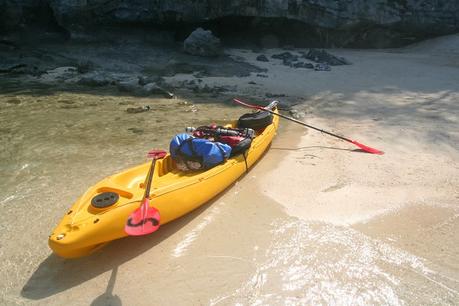
Canoes are also stable and due to their design, your gear is always well protected in the boat. However, this can be a problem when you encounter rough waters since it’s highly likely that your gear will move and may even get wet, a problem that can be addressed by using some bungee cords or tarps.
Kayaks, on the other hand, tend to have limited storage space, although the said space is usually very specific and provides several security options.
Most kayaks have an insider hull storage space, which happens to be waterproof in some models. This space is enough to keep your belongings and gear safe and secure. Additionally, there are kayak models that offer more storage space on the deck with bungee cords to secure your gear.
Durability
When you are buying a canoe or a kayak, one thing that you need to concern yourself with is how much abuse your boat will take.
Where will you be launching it from? Is it a pier or a stone-covered beach? How will you be transporting the kayak or canoe?
In such a case, durability should be at the top of the list. When it comes to this, kayaks tend to be more durable than canoes since they were designed initially for hunting hence needed to be tough, easy to carry and light in weight.
At the same time, while canoes don’t fall apart at the first scrape or bump, kayaks are designed for more rough and white water. They are meant to be dragged over rocks and shale beaches without ruining them. Most kayaks today are made of rotomolded polyethylene because it is highly durable.
How Wet You’ll Get
Due to their design, you will be drier in a canoe than a kayak. Paddling in a canoe ensures that you are higher above the water, hence less likely to get wet.
Once you have mastered the basic paddling techniques, you can even paddle on one side all the time hence avoiding the few drops that you might get from a dripping blade when you are changing sides.
At the same time, when it comes to kayaks, while the blades have drip blocks, it is impossible to avoid getting some drops in the end since you are constantly moving the blades above the water and hull level.
With sit inside kayaks, this is never a problem since you are always protected with a cover unlike with open or sit on top kayaks.
Additionally, when you encounter rough waters and extreme weather, you are better protected in a canoe since it sits higher above the water than in a kayak. However, for whitewater rapids and rough waters, a closed designed kayak with a cockpit will come in handy.
Way of Fishing
Just like with the world’s best kayak compass, kayaks win in this category due to the many specialized models of angling boats. They offer special storage as well as inserts that are molded into the kayak hull.
Such is ideal for solo anglers, although there are kayaks that work for two paddlers. While there are no specialized canoes that exist on the market, they have more storage space.
Canoes are also great for fishing since you can carry your fishing gear and anything else you may need on your trip. Even if there are no specialize inserts on canoes, you can attach a mounting system in yours outdoing any fishing kayak out there.
With a canoe, you can also bring along friends or family along on the trip, depending on how much space your canoe has.
Stability
When it comes to stability, canoes have a wider beam, which makes them more stable. However, this only applies when you are paddling on flat water, whereby it is much easier to get in and out of the canoe in such situations.
If you encounter difficulty in whitewater when you are in a canoe, the chances are that you will capsize. And as it is righting an overturned canoe is much more difficult if you are alone unless you have been trained in that or are physically stronger.
Kayaks, on the other hand, have narrow beams that make it difficult to get in and out of them, something that makes them not only feel but look unstable. They are, however, designed to handle fast and rough water.
Performance (Tracking, Speed and Maneuverability)
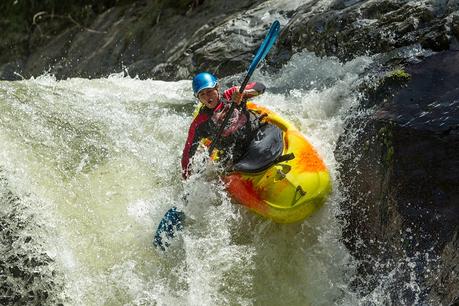
With beginners, paddling in a kayak is much easier than in a canoe. Kayaks tend to be narrow and are propelled using double-sided paddles alternating from one side to another in circular motions.
This is easy, even for beginners. The situation is, however, harder in a canoe since there are different strokes involved when paddling a canoe.
Since canoes are propelled from one side at a time with a single blade paddle, it is harder for beginners to maintain the right course. This means that for intermediate experienced paddlers and beginners alike, you are better off tracking in a kayak than a canoe.
To aid tracking, you have the option of choosing a model that has keel or an option to attach one in both canoes and kayaks. Maneuverability is impaired in a canoe if you happen to use a keel and you may not need it if you master the right canoe techniques.
When it comes to speed, kayaks tend to be faster than canoes due to their slim design. At the same time, kayaks are also easy to maneuver due to their narrow design as well.
How to Kayak
Step 1 – Decide on where you will be paddling
When you know where you will propel your kayak, the first thing that you need to ensure is that you know where you will go into the water. That said, you are better off choosing an area that is free of rocks, especially if you are a beginner.
Step 2- Put the kayak in the water
Decide first whether you will be entering the kayak on water or when you are still on the land. Once you are decided, you can glide the kayak into the water bow first.
Step 3 – Secure the kayak
Place your paddle at right angles behind the seat and up against the cockpit rim. You can then proceed to get inside your kayak, ensuring that you balance the weight to prevent tipping over.
Step 4 – Put the spray skirt
Lastly, ensure that the kayak is stable and then place it parallel to the shore in such a way that you can easily support yourself when you are putting on the spray skirt.
How to Canoe
Step 1 – Plan on what you will wear
The first thing you need to ensure before you even get into the water is deciding what you are going to wear. In warm weather, if the water is warm, you can do with shorts or a t-shirt and quick-dry pants.
It would, however, be in your best interest to bring a long-sleeved sweater in case you end up staying longer and need to protect yourself from the bugs.
Step 2 – Getting into the canoe
The first thing you need to ensure is that you have someone there with you so that they can ensure that you are secured to a dock at both ends.
Next, bend your knee and then crouch low and using both hands to hold the sides of the canoe, put one leg towards the center of the canoe.
If you put the right leg first, quickly bring the right hand over to grasp the other side of the canoe and then use your left hand if your left leg went in first.
After that, slowly bring the rest of the body into the canoe and ensure that you stay centered when doing that to avoid rocking your boat.
Step 3 – Forward paddling
You can either kneel or sit in a canoe facing forward at either the bow or stern. Hold the paddle with your inside hand on top and the waterside 2 to 3 feet down with the knuckles facing out.
Step 4 – Insert the blade and paddle
Ensure that you insert the blade as well as the paddle completely into the water, 2 feet in front of you or as far forward as you can reach without lunging yourself forward.
Push the top hand forward and then pull your bottom hand back such that you draw the blade through the water keeping the top of the paddle handles lower than your eye level.
After that, pivot your shoulder to draw the blade straight back, ensuring that you don’t follow the curve of the canoe.
Pull the blade through the water as far as the hip and then lift the blade out of the water and turn it parallel to the water to carry it forward to the starting position. You can then use the braking method to straighten the trajectory of your canoe.
Does More Spending Mean More Quality
When it comes to buying a canoe or a kayak, more spending does mean more quality. Your safety when on the water should be at the top of your list and you can only get that if you buy a quality boat.
High-end canoes and kayaks tend to be very stable whether you are standing, sitting or kneeling when paddling. They also have enough storage and leg space to ensure that you are as comfortable as possible when you are on the water.
Additionally, you must consider the durability of your kayak or canoe if you don’t want to be buying another boat in a couple of months. Kayaks tend to be more durable than canoes and can also handle rough water better.
Do’s and Don’ts With Kayaks and Canoes
Do’s
- Ensure that you oil the metal parts before you store your canoe or kayak to prevent rust that can damage your investment.
- Apply sun protective spray to minimize any sun damage that may occur when you are on the water or during storage.
- Consider both your weight and that of your gear when you are buying a kayak or canoe to ensure stability when on the water.
- Ensure that you are always wearing a plus-sized jacket when on the water and that there is someone with you if you are a beginner.
Don’ts
- Don’t overload your kayaks or canoe beyond the recommended weight capacity if you don’t want to tip over when you are on the water.
FAQ About Kayaks and Canoes
Is it easier to kayak or canoe?
While kayaks and canoes of the same length should, in theory, travel at the same speed, kayaks are generally light in weight than canoes, which means that it is easier to kayak than canoe due to the speed and ease of transport.
What’s better for fishing, kayak or canoe?
When it comes to fishing, kayaks are much more stable, even on rough water. On the other hand, canoes sit higher on the water than kayaks; hence fishing in them is less stable. With kayaks, your center of gravity is closer to the water, which creates more stability.
How wet would you get in a kayak vs a canoe?
When it comes to canoes and kayaks, you are likely to remain dry in a canoe due to the design and the fact that you remain higher above the water in a canoe than a kayak. With kayaks, sit-inside kayaks are way better at keeping you dry than sit-on-top ones.
Do kayaks flip over easily?
In general, kayaks don’t flip over easily when you are on the water. Chances of them flipping over is dependent on the type of kayak and type of water you are paddling on.
Is kayaking dangerous for non-swimmers?
Yes, kayaking is dangerous for non-swimmers, mainly because swimming is not a required skill in kayaking. If by any chance, you can’t float yourself in water, then you are better off not going kayaking.
Conclusion
Perhaps there will never be an end to the debate on whether kayaks are better than canoes. At the end of the day, they all have their pros and cons and whichever you get will highly depend on what you intend to do and the kind of waters you will be paddling in. One thing you need to ensure, however, is that you get a kayak or canoe that is highly durable and meets all your needs.
There are ways in which kayaks are better than canoes and vice versa. It is important to weigh everything before you purchase so that you don’t end up regretting your catch a trout with a spinning rod investment decision.
Photos from: jakgree / depositphotos.com, dmvphotos / depositphotos.com, lko-images / depositphotos.com, chudakov/ depositphotos.com, Kzenon / depositphotos.com, sportpoint / depositphotos.com, gonnjdi.gmail.com / depositphotos.com and ammmit / depositphotos.com.

